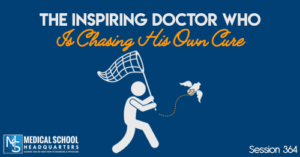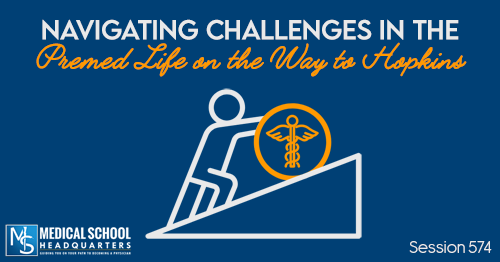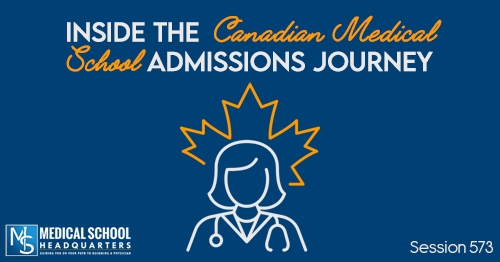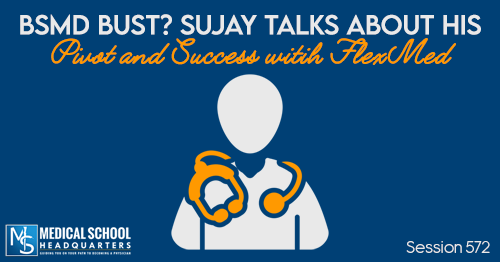Apple Podcasts | Google Podcasts

Session 364
Dr. David Fajgenbaum is both a researcher and a participant in the quest to cure his own devastating disease. How does this inspiring doctor stay motivated?
David has written a book about this whole process called Chasing My Cure. Today, he talks about he was a normal, healthy third-year medical student and playing college football until all of a sudden, things took a turn for the worst.
For more motivation and help with medical school applications, please be sure to check out all our other resources on Meded Media as we hope to make your medical school journey a bit easier.
Listen to this podcast episode with the player above, or keep reading for the highlights and takeaway points.
[01:50] Interest in Becoming a Physician and a Family Struggle
David has been drawn to medicine since he was young. He loved football and playing college football has been his dream. With each injury over the years, he got interested in sports medicine. He also wanted to be an orthopedic surgeon like his dad.
David has always been passionate about exercise, diet and nutrition, and sports medicine that it didn’t bother him whether his story was a cliche. After all, there was nothing else that he wanted to do more.
[Related episode: From College Athlete to Accepted Medical Student]
[04:10] A Shift of Interest in Specialty Inspired by His Mom
A few weeks after he played college football at this university, his life turned completely upside down when learned that his mom was diagnosed with a certain brain cancer called glioblastoma. So he went from a football player wanting to go into orthopedics and interested in going to medicine into a son who was devastated about his mom’s illness.
He watched doctors take care of her and her battle. From there on, he didn’t want to do orthopedics anymore. His interest shifted to getting involved in cancer research and treating cancer patients.
'Cancer changes every time so even if you have a good idea for the one point, you want to start to have a good idea for it in the future.'Click To TweetThis affected his studies tremendously. He was devastated. At the same time, this also got him to focus on his premed classes because he promised his mom that he was going to be a doctor. This became one source of his motivation to really work hard for it.
Additionally, he started a foundation in memory of his mom, who died in his sophomore year, which was a year after the diagnosis. The foundation is called AMF, which stands for his mom’s name, Ann Marie Fajgenbaum. It was initially geared for helping ailing mothers and fathers, and now actively moving forward. This organization enabled him to connect with other people.
[08:20] Balancing Studies and Sports
Being a student-athlete, you’d have to dedicate so much of your day to your sport and this can force you to be regimented with your time. This was the case for David as he didn’t do a single thing in college that wasn’t planned out.
'There wasn't a 15-minute window in my four years of college that wasn't planned out. Even social time was locked in.'Click To TweetIn hindsight though, David gets tired remembering the way he operated and lived during college. The David “now” would have probably taken some more breaks early on.
After college, he went to England to study Cancer Intervention in Oxford as part of his mission of taking on cancer. He came back to the United States to apply for medical school. He was taking the steps he thought he needed to achieve the promise he made to his mom.
[11:25] From Student to Patient
In the middle of his third year of medical school, he went from treating patients in the hospital to being a patient hospitalized in the ICU. He experienced multi-organ failure. Literally, over the course of days, he went from totally healthy to kidney failure, liver failure, and bone marrow shutdown. He gained about 70 pounds of fluid.
He had a retinal hemorrhage that made his left eye blind. He was getting daily transfusions. He was on a heating tube and literally dying in the ICU. It went on for 11 weeks without any diagnosis. It was just a multi-organ failure being kept alive by medical technology. They had no idea what it was that was killing him.
Eventually, a lymph node biopsy was done and got diagnosed with idiopathic multicentric Castleman Disease (iMCD). A day after the diagnosis, he was so sick that the doctor told his family to say their goodbyes. The priest already came in and administered his last rites to him.
Fortunately, because of the diagnosis that happened the day before, he got chemotherapy that day and it kicked in just in time and survived. Eventually, he went on multiple relapses. Three weeks after, he was back in the hospital with a multi-organ failure.
[13:10] The Problem
At least for his mom’s cancer, there are hundreds of researchers and hundreds of millions of dollars spent on glioblastoma research. All of a sudden, he was now in the world of rare diseases where there were only a handful of researchers and only tens and thousands of dollars on research investment.
The problem wasn’t that research wasn’t being done. The problem was that because research wasn’t being done, there were very few treatment options. This made him feel he wasn’t that important.
There are 30 million Americans that have a rare disease. One in ten Americans has a rare disease.
'There are 7,000 rare diseases and 95% of those do not have a single FDA-approved therapy.'Click To TweetFor most of them with a rare disease, they do feel they’ve been forgotten because there aren’t any treatments.
[14:23] What is Castleman’s Disease?
Castleman’s disease is a very poorly understood immune system disorder. When the immune system gets hyperactivated, it begins to attack your vital organs.
'In many autoimmune diseases, the immune system can attack one part of your body. In Castleman's disease, there's a full assault on your entire body.'Click To TweetThis disease can attack your entire body including your liver, kidneys, bone marrow, heart, and lungs. They begin to shut down due to a “cytokine storm.” Cytokines are the messengers the immune system uses to communicate with one another. When produced in high quantities, they can cause major organ dysfunction.
The disease is called idiopathic multicentric Castleman’s disease. By “idiopathic,” it means we don’t know what causes it. They don’t even know if it should be called an autoimmune disease or cancer. It acts like lymphoma which is a form of cancer. But it also looks a bit like an autoimmune disease.
If you don’t know what’s causing it, then the only solution that they’ve had historically is to just use chemotherapy to just kill the whole immune system.
[17:07] Finding the Expert and Undergoing Major Relapse
Medical school or becoming a doctor was the last thing he was worried about. Survival was the number one thing on his mind. He was literally dying and no one knew what was stopping it.
He initially thought that he wasn’t able going to fulfill the promise he made to his mom and he wasn’t going to make any difference in medicine. But more than anything, it was his mortality and not being able to marry his then-girlfriend and have kids that really hit him in the ICU.
As soon as he started to get better on chemo, the main thing on his mind was finding an expert. He needed to find out the person that knows more than anything else in the world about Castleman’s disease. He knew his medical training was put on hold until he could get his disease under control.
David did find a world expert in the disease in Little Rock, Arkansas. His name is Dr. Fritz Van Rhee. He’s a multiple myeloma expert.
Although Castleman’s disease is not defined as cancer, it has a lot of common with multiple myeloma. So he went to see Fritz and while he was out there, he had a major relapse despite the chemotherapy. He spent 7 weeks hospitalized in this institution.
He was on life support. He had a multi-organ failure. He was on feeding tubes, transfusions, everything you could ever imagine. This time, he didn’t only get one chemotherapy, but seven chemotherapies at once. That combination was able to completely obliterate his entire immune system and save his life.
He actually felt better with every dose of chemotherapy because his immune system was doing so much harm to his body.
'For me, it was, find the expert and get this thing under control before I can even worry about going back to medical school.'Click To TweetAt that point, too, Fritz started David on a drug that was undergoing a clinical trial. It was the first-ever randomized controlled trial that has ever been done for his disease. He started on the drug. He was also able to go back to medical school after one year on medical leave.
So he spent 6 months being hospitalized and 6 months recovering on this drug. He was hopeful it would keep him on remission and that he could get back on his previous plans. And that’s what he did. He went back to Penn Med and jumped right back on the oncology train.
[20:53] Taking a Medical Leave
There are actually not-so-great stories of medical students with medical issues that the want to take a medical leave and it’s not received very well.
In his case, he was received well by Penn Med. Many of them saw him in the ICU and so they saw the state he was in. His friends and classmates visited him constantly. It was something that they could physically see him. They knew the medical challenges and they even knew what his BUN levels were. This made sense to them as to how sick he really was.
From a residency standpoint, the question may come up as to how are residency program directors are going to view it if students needed to take time off as well as their stability throughout the program.
David, however, took a very nontraditional route. He was a healthy third-year medical student. He spent a year on medical leave. Then he was back to medical school. Unfortunately, he relapsed from that drug.
[22:20] Finding a Cure for Himself and Turning Hope Into Action
When he got back to medical school, he thought of getting back to his old plan. Do internal medicine and do oncology. But when he relapsed on the only drug in development for his disease, he realized he had to dedicate the rest of his in trying to identify treatment for himself.
No one was conducting active research at Penn but someone gave him some lab space. He started a foundation called the Castleman Disease Collaborative Network (CDCN). Their goal was to accelerate research on an international scale.
'If I wanted to survive, I would need to dedicate the rest of my life, however long that may be, in trying to identify a treatment for myself.'Click To TweetHe could no longer just hope that someone out there was going to figure out a solution for his disease and just go back to medical school and training. That was his lead turning point.
'I could no longer just hope someone else somewhere would figure this out... it wouldn't work for me if I just kept hoping. I turned my hope into action.'Click To TweetUnfortunately, he relapsed again a year later, right after he graduated from medical school.
Moreover, David realized that a lot of the challenges he was facing in this fight against Castleman’s disease were really organizational problems. People were not collaborating. There was a lack of a clear strategy. They were business problems.
So he thought of taking an MBA at Wharton and this would also have allowed him more time to keep him in the lab work he was doing.
When he relapsed, he really dove into his data. He survived again, thanks to the seven agents of chemotherapy. Then he began looking for a signal that could inspire trying a drug that may have never been used for his disease. He had run out of all treatments that have been used.
Data after data, day after day after day, he found that signal. He talked with his doctors and they decided to try him as the first patient ever with his disease to be treated with Sirolimus. That was five and a half years ago.
Despite nearly dying five times in the first three and a half years, it’s been five and a half years that David has been in remission.
He decided to use this time to continue to push the science for his disease. Rather than doing a residency after business school, he ended up taking a research faculty position at UPenn. He continued to build and grow his lab. Currently, he runs a transitional research lab that does basic science research, translation, and clinical research.
[26:10] Words of Wisdom for Premed Students
David shares a piece of advice to premed students to take their slivers of hope and turn them into action towards their goal of getting into medical school.
Often in our training, there’s setback after setback. And it can feel like a daunting journey of so many no’s with very few Yeses.
'Whatever it is you're hoping for, that should really drive your action.'Click To TweetWhen there is that decision between 15 minutes of Netflix and 15 minutes of studying, think about what you’re hoping for and will the 15 minutes of Netflix get you closer to what you’re hoping for. That’s not to say you can’t ever have Netflix and be happy.
It’s just important to remember that if you’re hoping for something, then do everything you can to make that thing actually become a reality. And generally, it’s going to require action. It’s going to require studying and working on evenings and weekends to try to make it a reality.
Having seen the bad side of medicine and how things aren’t being done, David thinks that there are medical schools that can rip down the optimism of students.
So by the time you’re done with your four years, you could go from being the most optimistic person into the least hopeful because of what you see during medical school. Residency would drill you down even further.
But throughout it, you’re given glimpses of hope during training and residency that keeps things in perspective and makes it all worthwhile.
When you go into medicine, you get the sense that there are no boundaries to medicine and it can cure all and it’s all-powerful. And as you go through your training, you recognize the limits of medicine. But maybe you thought there was a boundary. You thought this was the best you could do. You actually broke through the boundary and the patient got better than you expected.
'Stay focused on those highs and slivers of hope.' Click To Tweet[32:45] Advice on Interacting with Patients and Their Families
During medical school, we’re not really taught about interacting with family members and loved ones beyond the patient.
Don’t forget that there actually is this entire community of family members and friends that you don’t see every day that is very much affected by your patient’s illness. They’re very much a part of their journey. Interact with them and bring them into the loop. Make sure they feel empowered to share with you what they think is going on.
'There are observations that family members and patients will make that we as care providers need to make sure that we listen to.' Click To Tweet[Related episode: 7 Tips to Running a Successful Family Meeting]
[34:00] Chasing My Cure
Check out David’s book, Chasing My Cure. It’s a book about what he learned about life from nearly dying five times and some lessons he wants to share with the world.
The book also contains a number of perspectives pooled into one place into our health care system and into medical training.
Premed students and medical students can have an idea for what it’s going to be like and what are the things they can expect to see when they start taking care of patients.
Win one of 5 copies of this book. Go on to Instagram or Twitter and post a picture of you listening to this podcast. Tag me @medicalschoolhq and David @dfajgenbaum. Use #chasingmycure.
Links:
Chasing My Cure by Dr. David Fajgenbaum
Castleman Disease Collaborative Network (CDCN)
Sirolimus in Previously Treated Idiopathic Multicentric Castleman Disease











